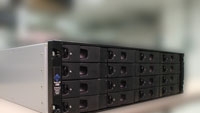The MediaCache 1000
Digital content for interactive TV systems, such as VOD, nDVR or delayed-broadcast video, has traditionally been stored on and streamed from standard magnetic media hard drives. While the cost per gigabyte for hard drives is low, the use of this storage medium for digital video streaming applications has introduced several performance and reliability limitations.
Hard drive limitations

Digital video files are quite large, and effective management and distribution of these files can adversely impact disk lifetimes. Medium and large VOD systems deploy hundreds of hard drives that have exhibited mean time between failures (MTBF) rates as low as several hundred thousand hours in VOD applications. Due to the relatively low I/O performance characteristics of hard drives in video applications, content may be duplicated multiple times to satisfy streaming requirements. This increases the number of hard drives necessary in a system, reducing overall reliability.
Other issues inherent to hard drives include relatively short service life, high power consumption and increased strain on limited available rack space.
A solid solution
Concurrent's MediaCache 1000 is a solid-state storage solution designed to mitigate performance challenges associated with spinning disk drives. The system uses commercial off-the-shelf (COTS) flash memory solid-state drives (SSDs) in a standard storage chassis to achieve densities in excess of 1000 hours of SD MPEG2 content. The performance is rated at 3000 simultaneous SD MPEG-2 streams, up to a 6X improvement over similar solutions in active title caching using regular hard drives. This increased performance allows for a 75-percent reduction in the storage needed to meet streaming requirements of active content.
Using solid-state storage has a direct affect on overall system reliability. Flash-based SSDs are specified to have about 3X the reliability of regular hard drives. This increased reliability, combined with the reduction in storage requirements, provides a 12X improvement in effective reliability for the storage system. SSDs also consume about 40-percent less power than regular hard drives. This savings, again combined with fewer drives overall, can provide an 80-percent reduction in storage power.
Get the TV Tech Newsletter
The professional video industry's #1 source for news, trends and product and tech information. Sign up below.
Wear-out is eliminated
The inherent wear-out mechanism in flash memory typically limits the number of write and erase cycles to a specified minimum of 100,000. Through multiple technical strategies, this wear-out limit has been eliminated in the MediaCache 1000. Although wear-leveling across the entire drive assures that all memory pages receive the same number of write and erase cycles over time, as in regular hard drives, pages of memory will eventually wear out. To combat this, a substantial quantity of extra flash memory is built into the drive.
Sophisticated data management and error detection and correction algorithms ensure that data is never lost. In a video streaming application, the anticipated service life of the drives due to flash memory wear-out is more than 200 years, much higher than that of regular hard drives.
Typical streaming video systems have a library of content that is considerably larger than the active content being streamed at any given time. The MediaCache 1000 is designed to be located with the video servers for storage or caching of this active content, where the performance is most advantageous. This allows the placement of video servers and associated active content storage in unmanned locations, such as at the edge, where performance counts and the added reliability reduces maintenance and provides peace-of-mind to the operator. The full library of content only needs to be stored once at a central, manned location using more cost-effective regular hard drives where maintenance isn't as big an issue.
John Fenley is a systems engineer for Concurrent.
